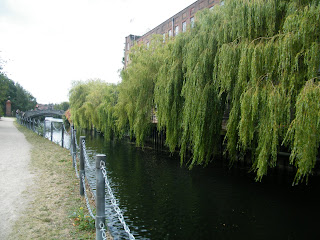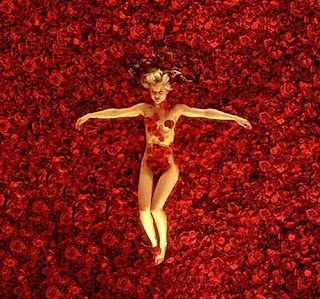The Costumes
Below are pictures of The New York Fund and of Razorlight, another indie/ rock band:

The New York Fund
 Razorlight
Razorlight
We can see that both bands share a similar image. Both wear dark skinny jeans, dark, open jackets/ cardigans, white t-shirts and checked shirts. The composition and stances are also very similar in the two pictures, as are the hairstyles also.
Topman is a very popular clothes shop and mainly sells clothes that fit into this genre, below is a link to the shop's website:



 This is a very generic indie outfit and is a representation of a widespread current trend of popular culture. The skinny jeans and checked shirt are instantly recognisable as indie signifiers, initially a symbol of individuality and unconventionalism. The popularity of this style has increased vastly on account of the popularity of such indie bands. Our protagonist must therefore fit into this trend so that a) his image is consistent with that of the band's and b) the target audience of the single (teenage boys/ young men aged 15-24) can relate to him as part of the current trend/ popular culture, as they themselves may be.
This is a very generic indie outfit and is a representation of a widespread current trend of popular culture. The skinny jeans and checked shirt are instantly recognisable as indie signifiers, initially a symbol of individuality and unconventionalism. The popularity of this style has increased vastly on account of the popularity of such indie bands. Our protagonist must therefore fit into this trend so that a) his image is consistent with that of the band's and b) the target audience of the single (teenage boys/ young men aged 15-24) can relate to him as part of the current trend/ popular culture, as they themselves may be.As for our actress, in film and art a female love interest is typically wearing at least one item of red clothing, or is associated with the colour red in some way (e.g. in Munch's 'Madonna' she has a red halo, in the opening scene of Sin City (2005) The Customer (Marley Shelton) wears red lipstick and a red dress, Mena Suvari lies on a bed of red roses in American Beauty (1999)). Therefore, it is important that our actress is represented in a similar way, as loveable and vulnerable but also as a seductress. 
Marley Shelton in Sin City (2005)
The Cast
We were quite unfortunate during our search for a male actor in the sense that our first choice actor (Guy Walker) pulled out. We had selected him for the part as he is a drama student and also does a lot of theatre work outside of school, therefore we felt his experience and confidence in front of an audience/ camera would serve well in our music video. However, he had to reconsider due to prior arrangements.

Guy Walker
We then had Johnny Lawrence lined-up as a replacement. We chose him due to his indie image and dress style. This would have caused less problems with regards to finding appropriate clothing, as his regular clothes would suffice. Furthermore, Johnny has a natural confidance and a general 'likable' factor, which would serve well as the target audience can relate to him easily. However, Johnny was also forced to reconsider due to a busy schedule of other commitments. Therefore, after an exhaustive search of possible and willing replacements, I myself was required to volunteer and play the part. In many ways, however, this will make the filming process much easier, as I already know what to expect from each shot and there would not be the usual difficulty of describing the shots and motions to the actor, as I would also be directing myself at the same time.
Me
On the other hand, we had more luck in our search for our actress, as our first choice has remained committed. We chose Isabel Davies to play our female part due to her attractiveness and sophisticated image, ensuring that she's believable as the highly sought-after love interest. Furthermore, she starred in one of our classmate's thriller opening sequence project, so she also has experience of the filming process, making her easier to work with.

Isabel Davies
Actress Withdrawal (12/10/09)
Unfortunately, Isabel Davies has also withdrawn from her part, due to a busy schedule and consequent unavailability.
With time running out, we decided on the simple option of having a second group member (Lucy Garstka) to play the part of our female alongside myself as the male protagonist. Although this is unfortunate, as Lucy doesn't have the acting experience of Isabel, at least we will never again have the problem of the actor/ actress being unavailable, as both parts are now played by group members.








 Old Post Office Court - This is perhaps not quite a narrow and scenic street which we originally set out to find, but the alley under the scaffolding provides an interesting location, giving good opportunities for interesting lighting effects as well as symbolic imagery such as entrapment.
Old Post Office Court - This is perhaps not quite a narrow and scenic street which we originally set out to find, but the alley under the scaffolding provides an interesting location, giving good opportunities for interesting lighting effects as well as symbolic imagery such as entrapment.  This is a nice shot of the alley, promising to be a potentially very effective location.
This is a nice shot of the alley, promising to be a potentially very effective location.  This is another nice shot. Although the man is there by chance in this particular picture, it suggests a good option for an effective long-range shot of a
This is another nice shot. Although the man is there by chance in this particular picture, it suggests a good option for an effective long-range shot of a  Quay Side - We spotted this charming row of Willows and realised it as a potentially very effective location. Willows are often used as
Quay Side - We spotted this charming row of Willows and realised it as a potentially very effective location. Willows are often used as 














